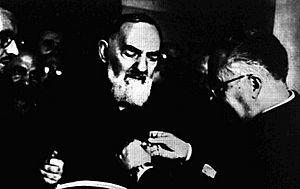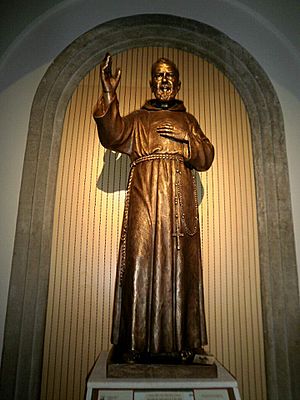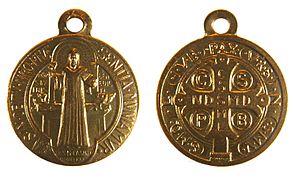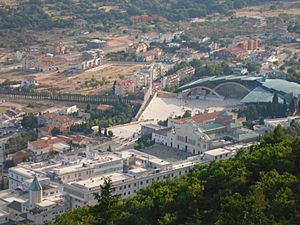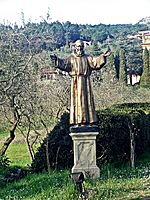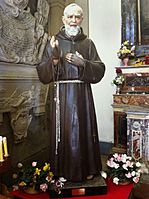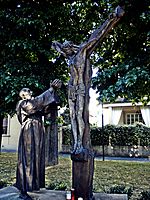Padre Pio facts for kids
Quick facts for kids SaintPio of Pietrelcina OFMCap |
|
|---|---|
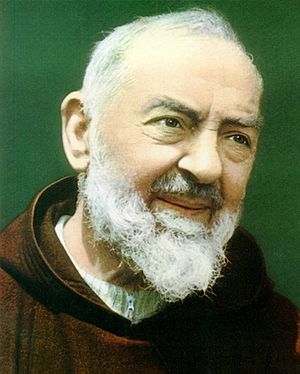
Official portrait photograph of Padre Pio, c. 1947
|
|
| Born | Francesco Forgione 25 May 1887 Pietrelcina, Province of Benevento, Kingdom of Italy |
| Died | 23 September 1968 (aged 81) San Giovanni Rotondo, Province of Foggia, Apulia, Italy |
| Resting place | Sanctuary of Saint Pio of Pietrelcina |
| Venerated in | Catholic Church |
| Beatified | 2 May 1999, Saint Peter's Square, Vatican City by Pope John Paul II |
| Canonized | 16 June 2002, Saint Peter's Square, Vatican City by Pope John Paul II |
| Major shrine | Sanctuary of Saint Pio of Pietrelcina in San Giovanni Rotondo, Italy, National Shrine, National Centre of Padre Pio in Barto, Pennsylvania, Parish and National Shrine of Saint Padre Pio in Santo Tomas, Batangas Philippines |
| Feast | 23 September |
| Attributes | Stigmata, Franciscan habit, sacerdotal vestments |
Francesco Forgione, known to many as Padre Pio or Saint Pio of Pietrelcina (Italian: Pio da Pietrelcina), was an Italian Franciscan Capuchin friar and priest. He was born on May 25, 1887, and passed away on September 23, 1968. He is honored as a saint in the Catholic Church, with his feast day celebrated on September 23.
Padre Pio joined the Capuchin order when he was just fifteen years old. He spent most of his religious life at the convent in San Giovanni Rotondo, Italy. In 1918, he was reported to have received the stigmata, which are marks on the body similar to the wounds of Jesus Christ. This led to several investigations by the Holy See (the Vatican).
Even though the Vatican temporarily placed some restrictions on him, his fame grew during his lifetime. Many people traveled to San Giovanni Rotondo to see him. He was also involved in building the Casa Sollievo della Sofferenza, a hospital near his convent.
After his death, devotion to Padre Pio continued to spread worldwide. He was declared "Blessed" on May 2, 1999, and then a "Saint" on June 16, 2002, by Pope John Paul II. His remains are now displayed in the sanctuary of Saint Pio of Pietrelcina. This place, next to his old convent, has become a major pilgrimage site for people from all over the world.
Contents
Life of Padre Pio
Early Years and Calling
Francesco Forgione was born on May 25, 1887, in Pietrelcina, a small town in southern Italy. His parents, Grazio Mario Forgione and Maria Giuseppa Di Nunzio, were farmers. He was baptized in the Santa Anna Chapel nearby, where he later served as an altar boy. Francesco had an older brother and three younger sisters.
His family was very religious. They went to Mass every day and prayed the Rosary each night. Francesco said that by age five, he had decided to dedicate his life to God. He worked on the family farm, looking after sheep, until he was ten.
When Francesco was ten, he caught typhoid fever. At six, he had suffered from severe gastroenteritis. As a young boy, Francesco said he had experienced heavenly visions. In 1897, after finishing public school, he felt called to become a friar after meeting a young Capuchin friar.
His parents supported his wish. They visited a Capuchin community in Morcone to see if Francesco could join. The friars said he needed more education. So, Francesco's father went to the United States to work and earn money for his son's private lessons. Francesco received the sacrament of Confirmation on September 27, 1899.
On January 6, 1903, at age 15, Francesco entered the Capuchin friars' training center in Morcone. On January 22, he took the Franciscan habit and the name Fra (Friar) Pio. He chose this name to honor Pope Pius I. He also took simple vows of poverty, chastity and obedience.
Becoming a Priest
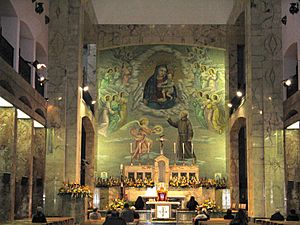
Pio began seven years of study to become a priest. He traveled to the friary of Saint Francis of Assisi in Umbria. When he was 17, he became very ill. He lost his appetite, couldn't sleep, felt exhausted, and had bad headaches. He often vomited and could only eat milk and cheese.
Some people believe that during this time, unusual things started to happen around him. For example, during prayers, Pio sometimes seemed to be in a trance. One friar even claimed to have seen him floating above the ground.
In June 1905, Pio's health got worse. His leaders sent him to a mountain convent, hoping the fresh air would help. But it didn't, and doctors told him to go home. Even at home, his health didn't improve much. Despite this, he made his solemn profession on January 27, 1907.
In 1910, Pio was ordained a priest by Archbishop Paolo Schinosi. Four days later, he celebrated his first Mass. Because his health was so poor, he was allowed to stay with his family until 1916, while still being a Capuchin friar.
On September 4, 1916, Pio was asked to return to community life. He moved to the Our Lady of Grace Capuchin Friary in San Giovanni Rotondo. He stayed there until his death in 1968, except for a short time serving in the military. As a priest, Padre Pio was known for helping many people convert to Catholicism.
Padre Pio loved to pray the Rosary. He compared weekly confession to dusting a room every week. He also suggested meditating and checking your conscience twice a day. His famous advice was: "pray, hope, and don't worry." He told Christians to see God in everything and to always want to do God's will.
Many people traveled to San Giovanni Rotondo to meet him. They came to confess, ask for help, or just out of curiosity. Padre Pio's mother died near the convent in 1928. Later, his elderly father and brother also moved nearby. His father lived in a small house outside the convent until he died in 1946.
World War I and Its Impact
When World War I began, four friars from Pio's community joined the Italian army. Pio was a teacher and spiritual guide at the seminary. When another friar was called to serve, Pio became in charge of the community. On November 15, 1915, he was drafted into the army.
Due to his poor health, he was often sent home and then called back. Finally, on March 16, 1918, he was declared unfit for service and fully discharged.
After the war, people were rebuilding their lives. Many saw Padre Pio as a symbol of hope. Those close to him said he began to show several special spiritual gifts. These included healing, bilocation (being in two places at once), and prophecy. He was also said to have performed miracles and had extraordinary strength, sometimes going without much sleep or food. People also reported that he could read hearts and speak in different tongues.
Padre Pio became very well known. He became a spiritual guide for many. He taught five rules for spiritual growth: weekly confession, daily Communion, spiritual reading, meditation, and examining one's conscience.
Vatican's Changing Views
In 1933, Pope Pius XI allowed Padre Pio to celebrate Mass publicly again. He said, "I have not been badly disposed toward Padre Pio, but I have been badly informed." In 1934, the friar was also allowed to hear confessions again. He was even given special permission to preach, even though he had not taken the usual exam for it. Pope Pius XII, who became pope in 1939, encouraged people to visit Pio.
By the mid-1960s, Pope Paul VI dismissed all past accusations against Padre Pio. This meant the Church fully supported him.
Building a Hospital
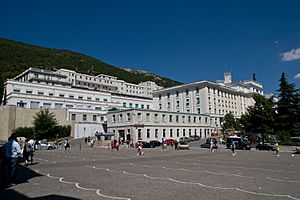
By 1925, Padre Pio had turned an old convent building into a small medical clinic. It had a few beds for people who were very sick and poor. In 1940, a group was formed to build a larger hospital, and donations started coming in. Construction began in 1947.
The hospital was named the Casa Sollievo della Sofferenza (Home for the Relief of Suffering). It opened in 1956. Padre Pio gave control of the hospital directly to the Holy See. To allow Pio to oversee the project, Pope Pius XII even gave him special permission to not follow his vow of poverty in 1957.
Padre Pio's Death
Padre Pio's health got worse in the 1960s, but he kept up his spiritual work. On September 21, 1968, the day after his 50th anniversary of receiving the stigmata, he felt very tired. The next day, September 22, 1968, he was supposed to celebrate a special Mass. Feeling weak, he asked if he could say a simpler Mass instead. But because so many pilgrims were there, his superior decided the special Mass must go on.
Pio performed his duties but looked very weak. His voice was faint, and after Mass, he almost collapsed walking down the altar steps. His Capuchin brothers had to help him. This was his last Mass.
Early on the morning of September 23, 1968, Padre Pio made his last confession and renewed his Franciscan vows. He held his rosary but was too weak to pray aloud. He kept repeating "Gesù, Maria" (Jesus, Mary). Around 2:30 a.m., he said, "I see two mothers," which was believed to mean his own mother and Mary. He died in his cell in San Giovanni Rotondo, whispering "Maria!" with his last breath.
His body was buried on September 26 in a crypt. Over 100,000 people attended his funeral Mass. He often said, "After my death, I will do more. My real mission will begin after my death." Those who were with him at the end said his stigmata had completely disappeared without a scar. Only a red mark remained on his side, but it also vanished.
Reported Supernatural Experiences
Padre Pio was said to have many mystical gifts. These included being able to read people's souls, being in two places at once, and performing healings even before people asked for them. He also reported having visions of heavenly beings and even physical struggles with Satan and demons. These reports of supernatural phenomena made him very famous, though the Vatican was at first unsure about them. Some of these experiences were written by Pio himself in letters, while others were reported by his followers.
The Stigmata
Padre Pio wrote in his letters that early in his priesthood, he felt pain and saw bleeding marks on his body. These marks were in the places where Jesus was wounded on the cross, known as the stigmata. In a letter from 1912, Pio wrote about his strong connection to Christ's suffering and felt he would bear the stigmata.
In 1915, he said he had experienced visions since he was a new friar (around 1903-1904). He also confirmed he had the stigmata, but he was so scared by them that he asked God to make them disappear. He said he wanted the pain to stay, but not the visible wounds, because he felt very embarrassed by them.
On September 20, 1918, while hearing confessions, Pio said the physical stigmata appeared again. His stigmata were reported to have stayed for fifty years, until he died. People said the blood from the stigmata smelled like perfume or flowers. Pio often wore red mittens or black coverings on his hands and feet because he was embarrassed by the marks.
Some doctors who examined the wounds had different ideas about them. Some said the wounds were unexplainable and never seemed to get infected. They would heal and then reappear. Others suggested the wounds might have been caused by chemicals. However, many people, including Church officials, believed the stigmata were real and supernatural.
Transverberation
In August 1918, a few weeks before receiving the stigmata, Pio described a special mystical experience. He felt as if he was spiritually and physically pierced and burned. This experience lasted from August 5 to August 7. His spiritual director believed this was a transverberation, a mystical piercing of the heart. Pio later said this experience left a physical wound on his left side. Many witnesses who saw Pio's wounds reported a cross-shaped wound on his left side, about three inches long.
Being in Two Places at Once (Bilocation)
Followers of Padre Pio believed he had the gift of bilocation, meaning he could be in two places at the same time. Many people claimed to have seen Pio in different parts of the world, even though it is known that he never left San Giovanni Rotondo from 1918 until his death.
Pio himself reported a bilocation experience in 1905 when he was a young student. He wrote to his spiritual director that he was in the choir with another friar when he suddenly found himself far away in a house. There, he saw a father dying while his wife was giving birth to a baby girl. Then, he was suddenly back in the choir.
When asked about bilocation by a Vatican investigator, Pio said he didn't understand how it happened. He explained that he would find himself in the presence of a person or in a different place, but he didn't know if his mind was transported or if it was a vision.
Miraculous Healings
In a book from 1999, Padre Pio: The Wonder Worker, there is a story about Gemma de Giorgi, a girl from Sicily who was born blind. It is believed her sight was restored during a visit to Padre Pio in 1947. Gemma was brought to San Giovanni Rotondo by her grandmother. During her trip, the little girl started to see things, like a steamboat and the sea.
Gemma's grandmother didn't believe the child had been healed at first. After Gemma forgot to ask Pio for grace during her confession, her grandmother begged the priest to ask God to restore her sight. Pio told her, "The child must not weep and neither must you for the child sees and you know she sees."
A bishop named Raffaele Rossi, who investigated Pio, noted that many reported healings were not officially confirmed. However, he also said that some credible statements in Padre Pio's letters attributed miracles to his prayers.
Odor of Sanctity
Many witnesses reported that a mysterious, pleasant smell, like perfume or flowers, seemed to come from Pio's stigmata. This phenomenon is often called the odour of sanctity. A Vatican investigator, Rossi, also noted this scent. In his report, he described it as a "very intense and pleasant fragrance, similar to the scent of the violet," and he could not find its origin.
Visions of Heavenly Beings
In his letters to his spiritual directors, Padre Pio often wrote about frequent visions of heavenly beings. These included visions of Jesus and Mary and visions of his guardian angel. He said these visions started soon after he became a friar in 1903. When asked if these visions were real or just in his mind, he said they were "intellectual visions" seen with the "eyes of the intellect."
Battles with Demons
Padre Pio reported frequent physical attacks from Satan and evil creatures. He described in his letters that demons would physically beat or torment him. A Vatican investigator confirmed that there were accounts of such attacks against Pio. When asked, Pio said he had experienced evil visions that looked like humans and beasts.
Prophecy
In 1947, a 27-year-old priest named Karol Józef Wojtyła (who later became Pope John Paul II) visited Padre Pio and went to confession with him. A cardinal later reported that Wojtyła told him Padre Pio had said he would one day reach "the highest post in the church." However, Pope John Paul II's secretary denied this prediction.
Reading Hearts
It was reported that Padre Pio could read into people's hearts. For example, he seemed to know their sins supernaturally when they came to him for confession. When a Vatican investigator asked him about this ability in 1921, Padre Pio confirmed it. He said, "A very few times I happened to feel inside me with clarity someone's fault, or sin, or virtue, of people of whom I had some knowledge."
Vatican Investigations
The Vatican initially placed strict rules on Padre Pio in the 1920s to reduce public attention. He was not allowed to say Mass publicly, bless people, or show his stigmata. There were also plans to move him to another convent, but local people protested strongly, so he stayed. From 1921 to 1922, he was prevented from performing some priestly duties. From 1924 to 1931, the Holy See stated that the events in Pio's life were not due to divine causes.
However, several medical and Church investigations took place. Some doctors examined his wounds and had different opinions, with some suggesting natural causes and others finding them unexplainable. Church officials also conducted inquiries.
In 1921, Bishop Raffaele Rossi was sent by the Holy Office to investigate Padre Pio. After eight days, he wrote a positive report, stating that Pio was a good religious man and his stigmata could not be explained as a trick or the work of the devil. He saw the stigmata as a "real fact."
Later, in 1960, Father Carlo Maccari conducted another investigation. He had a more critical view, suggesting that Pio's environment was overly enthusiastic and that there was too much mixing of sacred and human elements. Following Maccari's report, Pope John XXIII noted in his diary that he saw Padre Pio as a "straw idol," meaning someone whose fame was perhaps exaggerated.
Despite these differing views and investigations, the Church eventually recognized Padre Pio's holiness, leading to his beatification and canonization.
Padre Pio's Personal Views
His Religious Beliefs
Padre Pio strongly believed in weekly confession, calling it "the soul's bath." He gave five rules for spiritual growth: weekly confession, daily Communion, spiritual reading, meditation, and regular self-examination. He taught his followers that suffering can be a special sign of God's love, helping them to be more like Jesus.
Padre Pio also held strong views on modesty. He believed people should dress respectfully, especially in church. He emphasized obedience to the Church, even when he was troubled by some changes. For example, after the Second Vatican Council, he was sad about some changes but still asked people to obey the Church's decisions.
As he got older, Padre Pio became very wary of television. He believed it could harm family life and warned people not to buy one. He even said, "The devil is in it!" when asked about movies.
Towards the end of his life, Padre Pio became quite worried about the state of the world. When asked about the future, he replied, "Can't you see the world is catching on fire?" In his last years, he felt unworthy and often asked his superior, "Give me the obedience to die."
His Political Views
Padre Pio wasn't deeply involved in politics, but he did vote in Italian elections and shared his thoughts on some issues. He initially thought Benito Mussolini had done a good job, but his opinion changed negatively over time. He once told Mussolini's messenger that nothing could save Italy after what Mussolini had done.
He also admired U.S. President Franklin D. Roosevelt, calling him a "great man." Padre Pio was very concerned about the spread of communism and often prayed to fight against it.
In 1948, he supported the Christian Democracy party in a letter. His involvement is believed to have helped the party win elections, making Italian communists dislike him. One communist spokesman complained that Pio's presence at the voting polls "took votes away from us."
After the Christian Democracy party's victories, Italian political leaders often sought Padre Pio's prayers and advice. He also received letters requesting his prayers from figures like King Alfonso XIII of Spain and prayed for King George V of the United Kingdom.
In 1963, when John F. Kennedy was assassinated, Padre Pio cried. When asked to pray for Kennedy's soul, Pio said, "It's not necessary. He's already in Paradise."
Some historians suggest that a "clerical-fascist mixture" developed around Padre Pio. For example, in 1920, he blessed a flag for a group of veterans who were trying to connect with local fascists to fight communists. He also became the confessor for a fascist politician from Foggia, who then formed a "guard" around Padre Pio to prevent him from being moved from the monastery.
After His Death
Becoming a Saint
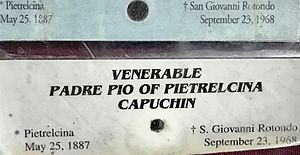
In 1982, the Holy See allowed an investigation to begin to decide if Padre Pio should be made a saint. This investigation lasted seven years. In 1990, Pio was declared a Servant of God, which is the first step in becoming a saint.
The investigation looked into how Padre Pio lived his life. In 1997, Pope John Paul II declared him venerable. Then, cases of reported miracles were studied, such as the healing of an Italian woman, Consiglia de Martino, which was linked to Padre Pio's prayers. In 1999, Pope John Paul II declared Padre Pio "Blessed."
After more study of his good deeds and his ability to help people even after his death, including another healing attributed to him, Pope John Paul II declared Padre Pio a saint on June 16, 2002. About 300,000 people attended the ceremony in Rome.
Pilgrimage Sites
The town of San Giovanni Rotondo, where Padre Pio lived most of his life, is now the main place people visit to honor him. The Santa Maria delle Grazie Church, where he celebrated Mass, became a pilgrimage site after his death in 1968. As more and more pilgrims came, a new, larger shrine was built nearby.
The Sanctuary of Saint Pio of Pietrelcina opened on July 1, 2004. It can hold about 6,000 people inside, and its outdoor area can hold 30,000. Padre Pio's remains are in the crypt of this new sanctuary, where pilgrims can see them.
Pietrelcina, Padre Pio's birthplace, is another popular pilgrimage site. Visitors can see his family home, his room in an old tower where he stayed when he was sick, and the churches where he was baptized and ordained. It's estimated that about two million pilgrims visit Pietrelcina every year.
Outside Italy, there are also places dedicated to Padre Pio, like the Padre Pio Shrine in Santo Tomas, Batangas, in the Philippines, and the National Center for Padre Pio in Barto, Pennsylvania, in the United States.
Popes Visiting Padre Pio's Shrines
Popes have encouraged devotion to Padre Pio by visiting the places connected to his life. San Giovanni Rotondo, where Padre Pio lived and where his shrine is, has been visited by Pope John Paul II, Pope Benedict XVI, and Pope Francis. Pietrelcina, his birthplace, was visited by Pope Francis.
As a young priest in 1947, Karol Wojtyła (who became Pope John Paul II) visited Padre Pio. He returned to San Giovanni Rotondo as a cardinal in 1974 and again as Pope John Paul II in May 1987, to celebrate Padre Pio's 100th birthday.
On June 21, 2009, Pope Benedict XVI visited San Giovanni Rotondo. He saw Padre Pio's remains, celebrated Mass, and met with sick people and hospital staff.
Pope Francis also supports devotion to Padre Pio. In 2016, he asked for Padre Pio's remains to be displayed in St. Peter's Basilica. On March 17, 2018, he visited both Pietrelcina and San Giovanni Rotondo to mark 50 years since Padre Pio's death.
Exhumation and Display
On March 3, 2008, Padre Pio's body was taken from his crypt, 40 years after his death, to be prepared for display. Church officials said the body was in "fair condition." The archbishop noted that the top of the skull was partly skeletal, but the chin was perfect, and the rest of the body was well preserved. He also confirmed that the stigmata were no longer visible.
To make his face recognizable, a lifelike silicone mask was placed over it. This mask was made from a 1968 photograph of Padre Pio.
On April 24, 2008, Padre Pio's body went on display in a special glass, marble, and silver tomb. He was dressed in his brown Capuchin habit with a white silk stole and held a large wooden cross. Over 800,000 pilgrims reserved to see the body. The display was extended through September 2009.
In April 2010, Padre Pio's remains were moved to a special golden crypt in the church of Saint Pio.
Worldwide Devotion
Padre Pio has become one of the most popular saints around the world. There are over 3,000 "Padre Pio Prayer Groups" with three million members globally. The first parish named after Saint Padre Pio was established in Kleinburg, Ontario, Canada, on June 16, 2002. There are also parishes and shrines dedicated to him in places like New Jersey, Australia, and the Philippines.
A 2006 survey found that more Italian Catholics pray to Padre Pio for help than to any other saint.
Padre Pio's remains were brought to the Vatican for veneration during the 2015–2016 Extraordinary Jubilee of Mercy. He and Saint Leopold Mandic were chosen as saint-confessors to inspire people to reconcile with the Church and God through confession.
Saint Pio of Pietrelcina was named the patron saint of civil defense volunteers in Italy. He is also informally known as the patron saint of stress relief and the "January blues," with a "Don't Worry Be Happy Day" celebrated in his honor. This is inspired by his famous advice: "Pray, hope, and don’t worry."
Padre Pio in Art
Padre Pio's image is widely used on religious items and statues in Italy and worldwide. His portrait can be seen in many churches, homes, and public places like shops and restaurants. In religious art, he is usually shown in his brown Capuchin habit with gloves covering his stigmata.
Statues of Padre Pio have been put up in Italy and other countries, including the United States, the Philippines, and Malta. In 2002, a statue of Pio in Messina, Sicily, gained attention when it was said to have wept tears of blood. There is even an underwater statue of Padre Pio near the island of Capraia in the Mediterranean Sea, submerged in 1998.
In 2021, construction began on a new sanctuary dedicated to Padre Pio in the Philippines, featuring a 100-foot-tall statue of him. The same year, a new statue of Padre Pio was unveiled at the Padre Pio Shrine in Santo Tomas, Batangas, Philippines.
Images for kids
-
Padre Pio showing the stigmata (detail from a photo from August 19, 1919)
- Sculptures of Padre Pio in Italy
-
Sculpture of Pio of Pietrelcina in Villa di Galceto in the province of Prato
-
Sculpture of Padre Pio with Jesus on the cross in Prato, Italy
See also
 In Spanish: Pío de Pietrelcina para niños
In Spanish: Pío de Pietrelcina para niños
- Padre Pio: Miracle Man
- Padre Pio (film)
- Padre Pio TV
- Sanctuary of Saint Pio of Pietrelcina
- Victim soul
- Visions of Jesus and Mary




